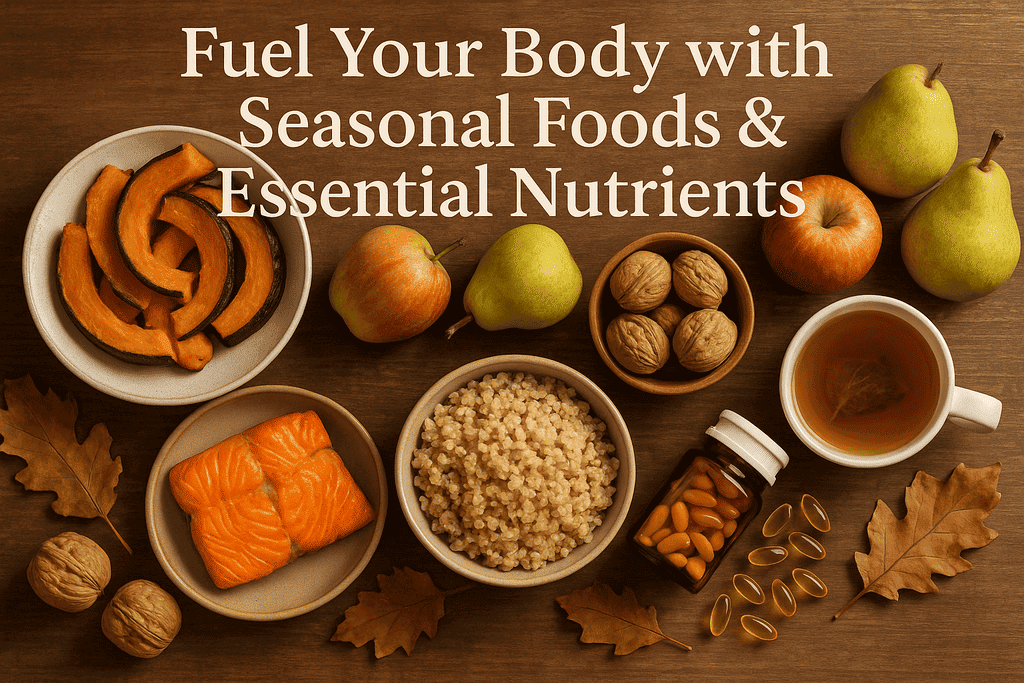
Introduction
As the days shorten, temperatures drop, and humidity shifts, your body, mood, and performance change too. Transitioning your workout plan and nutrition for fall weather helps you stay energized, avoid seasonal illnesses, and maintain gains you made during summer. This guide gives a practical, science-backed fitness routine and nutrition plan tailored for autumn — with SEO-friendly language, clear action steps, a sample weekly plan, and citations to recent scientific and medical studies from Asia, America, and Europe. Key takeaways are highlighted so you can implement change quickly.
Key points (at a glance):
- Adjust training intensity, layering, and warm-ups for cooler temperatures. PMC+1
- Prioritize vitamin D, protein, and seasonal produce to support immunity and mood. Frontiers+1
- Maintain hydration even when you don’t feel as thirsty; dry air raises fluid needs. ACSM
- Use light exposure and sleep hygiene to prevent seasonal mood changes. Nature+1

Body
Why fall requires a different approach
Autumn brings cooler temperatures, lower sunlight exposure, and altered daily activity patterns. Research shows daily step counts and physical activity often drop in colder months, especially among older adults, which can reduce cardiovascular conditioning and mood benefits of consistent movement. A recent community-based study found measurable seasonal declines in daily steps and physical function during cooler months. PMC
Moreover, vitamin D levels and related immune or mood outcomes tend to decline with shorter daylight hours; global analyses show widespread seasonal insufficiency in many regions. Addressing this with diet, sensible supplementation, and daylight exposure is important for resilience during fall and winter. Frontiers+1
Training adaptations for cooler weather
Principles to follow:
- Longer warm-ups: Muscles are stiffer in cool air — increase warm-up time (10–20 minutes dynamic warm-up) to raise muscle temperature and reduce injury risk. ACSM
- Layering and gear: Wear moisture-wicking base layers, insulating mid-layers, and windproof outerwear. Protect extremities (gloves, hat) to prevent heat loss and frostbite risk when temperatures drop. acefitness.org+1
- Adjust intensity by conditions: In cold, still-reasonable temperatures, maintain typical intensity. In very cold, windy, or icy conditions, prefer lower-intensity workouts, indoor alternatives, or interval formats to limit risk. ACSM guidance recommends caution and modifying exercise in extreme cold. PMC+1
- Emphasize mobility & neuromuscular control: Include balance, mobility, and plyometric prep to offset decreased proprioception on wet/leaf-strewn ground.
Sample fall training split (4 weeks, repeatable):
- Monday: Strength full-body (45–60 min) + 10–15 min mobility warm-up
- Tuesday: Moderate outdoor run or indoor bike (30–45 min) — focus on steady-state aerobic conditioning
- Wednesday: Active recovery (yoga, brisk walk, foam rolling)
- Thursday: High-intensity intervals (20–30 min) or hill repeats (if safe surface)
- Friday: Strength (lower-body focus) + core (40–60 min)
- Saturday: Long lower-intensity outdoor endurance (60–90 min) or indoor group class
- Sunday: Rest or light mobility

Nutrition priorities for fall
Fall calls for immune-supporting nutrition, maintenance of lean mass as activity patterns shift, and attention to mood-related nutrients.
Nutrient focus:
- Protein: Maintain 1.2–1.6 g/kg/day (depending on activity) to preserve muscle mass during seasonal drops in activity. Protein timing (distributing across meals) supports recovery. (General sports-nutrition consensus: strength/endurance athletes require higher protein intakes.) PMC
- Vitamin D: With less sun exposure, monitor vitamin D status and consider supplementation if low. Global reviews show that many populations experience insufficiency in colder months; supplementation may reduce some mood and immune risks, though dose and individual needs vary. Consult a clinician for testing and dosing. Frontiers+1
- Micronutrients for mood and immunity: B vitamins, vitamin C, zinc, and omega-3 fatty acids play supportive roles. Recent nutrition reviews highlight seasonal relevance of B vitamins and vitamin D for mood disorders like SAD. MDPI+1
- Hydration: Cold air is often dry; you still lose fluids through respiration and sweat under layers. Aim for regular fluid intake and include electrolytes during long workouts. ACSM
Fall-friendly foods to emphasize:
- Seasonal produce: Squash, pumpkins, root vegetables, apples, pears — high in fiber and micronutrients.
- Fatty fish & plant omega-3s: Salmon, sardines, flaxseed, walnuts.
- Fortified dairy or alternatives: For vitamin D and calcium.
- Lean proteins: Poultry, legumes, eggs, tofu, dairy.
- Fermented foods: Yogurt, kefir, sauerkraut — for gut health and immune resilience.

Sample weekly meal plan (simple table)
| Meal | Example (Fall-friendly) | Notes |
|---|---|---|
| Breakfast | Oatmeal with milk, chia, apple slices, cinnamon, and a scoop of protein powder | Fiber + protein + seasonal fruit |
| Mid-morning snack | Greek yogurt with walnuts and honey | Protein + omega-3s |
| Lunch | Roasted pumpkin & chickpea salad with mixed greens, quinoa | Complex carbs + plant protein |
| Afternoon snack | Pear + handful of almonds | Quick energy + healthy fats |
| Dinner | Baked salmon, roasted root vegetables, steamed greens | Protein + vitamin D (fish) |
| Evening | Chamomile tea; if low vitamin D, take supplement per doctor | Sleep hygiene + supplementation if indicated |
(Adjust portions to caloric needs and activity level.)
Managing mood, sleep, and daylight
Shorter days can trigger mood changes or Seasonal Affective Disorder (SAD). Recent longitudinal studies indicate seasonal and weather-linked variations in depressive symptoms and show interactions with physical activity. Strategies include:
- Light exposure: Aim for morning daylight (10–30 minutes) to stabilize circadian rhythms; consider light therapy for clinically significant SAD. Nature+1
- Sleep consistency: Fixed bed and wake times preserve recovery and hormone balance.
- Maintain activity: Even short daily walks increase daylight exposure and physical activity — both protective against mood decline. PMC
Injury prevention, safety, and modifications
- Check wind chill and surface conditions before outdoor workouts; avoid slippery routes. Use traction devices on shoes if needed. American Family Care+1
- For asthma or exercise-induced bronchoconstriction, cold air can be a trigger — use a scarf or buff over mouth, and have rescue inhaler if prescribed. Verywell Health
Conclusion
Adapting your fitness routine and nutrition plan for fall is about smart, small changes that protect performance, maintain muscle, and support immune health and mood. Focus on longer warm-ups, proper layering, maintaining protein intake, monitoring vitamin D, and prioritizing daylight and sleep. Implement these adjustments gradually over 1–2 weeks as temperatures shift — consistency beats perfection.
SEO-friendly keywords (use in headings, meta, and social shares): fall fitness, autumn workout plan, seasonal nutrition, vitamin D in fall, cold-weather exercise tips, immune-supporting foods, fall meal plan, seasonal affective disorder prevention, hydration in cold weather, strength training fall.
References
- Gatterer H., et al. Practicing Sport in Cold Environments. Sports (Basel). 2021. PMC
- American College of Sports Medicine (ACSM). Exercising in the Cold / Expert guidance and blog posts (ACSM). ACSM+1
- Kubota A., et al. Seasonal changes in daily steps of community-dwelling older adults (2024). PMC article on seasonal activity declines. PMC
- Frontiers in Nutrition. Cui A., et al. Global and regional prevalence of vitamin D deficiency (2023). Frontiers
- Xie F., et al. Effect of vitamin D supplementation on incidence and negative emotions (meta-analyses / PMC 2022). PMC
- Nature (2025). Zhang Y., et al. Assessing seasonal and weather effects on depression — seasonal mood interplays with activity. Nature
- ACE Fitness. Strategies for Outdoor Wintertime Activity (practical clothing and safety tips). acefitness.org
- Verywell Health / clinical summaries. When running in the cold is a smart vs. bad idea (overview of risks like exercise-induced bronchoconstriction). Verywell Health
- MDPI Nutrients (2024). Jahan-Mihan A., et al. The Role of Water-Soluble Vitamins and Vitamin D in Mood and Immunity (review). MDPI






